One to one maths interventions built for KS4 success
Weekly online one to one GCSE maths revision lessons now available
In order to access this I need to be confident with:
This topic is relevant for:

Here we will learn about ratio, including simplifying ratios, dividing a ratio into a quantity, ratios to fractions, and problem solving with ratios.
There are also ratio worksheets based on Edexcel, AQA and OCR exam questions, along with further guidance on where to go next if you’re still stuck.

What is ratio?
Ratio is a relationship between two or more quantities showing the number of times one is contained within the other(s).
Ratios are written in the form a:b , which is said “ a \ to \ b ” where a and b are normally integers, fractions or decimals.
They can also be represented in the form \frac{a}{b} (a fraction).
The order of the quantities in the ratio is important.
If there are 10 boys in a class and 15 girls, we can say that the ratio of boys to girls is 10:15 which we say as “ 10 to 15 ”.
Ratios are used in real life very frequently.
We use ratios to bake cakes, convert currencies when you go on holiday, determine the shutter speed on a camera, draw scale models of buildings, calculate the speed of a car, determine the aspect ratio of television screens, read maps and many many more!
In the GCSE mathematics curriculum, topics that use ratios include the above as well as trigonometry, calculating the gradient of a line, measuring density or pressure of an object, calculating best value for money, speed calculations, and even within sampling techniques.
See also: 15 Ratio questions
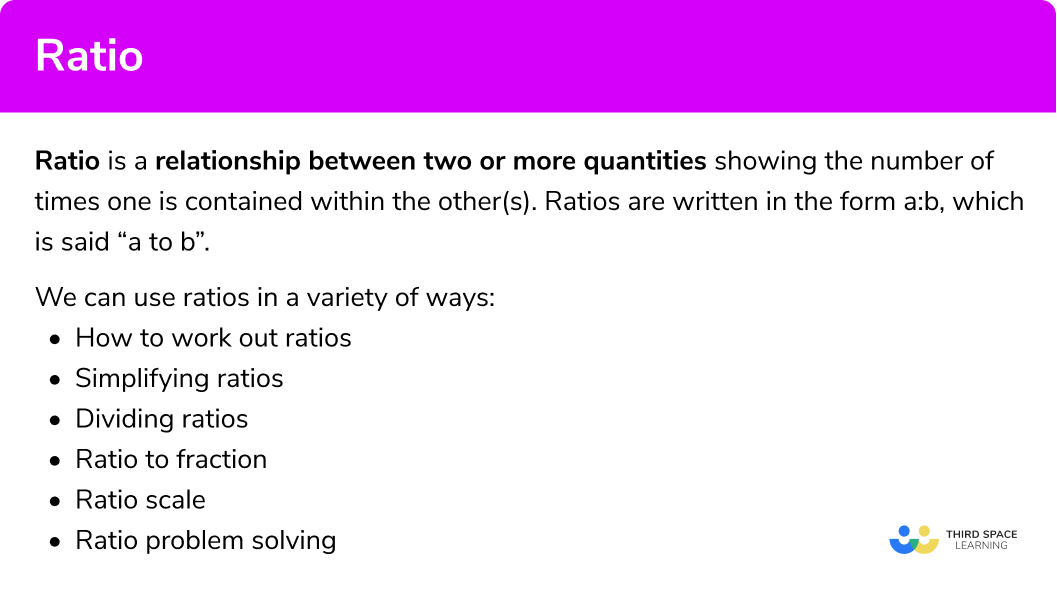
How to use ratios
We can use a variety of methods when interpreting ratios:
Working out ratio
A ratio can be written as a part to part and a part to whole.
We explore how to write a relationship as a ratio, manipulate ratios and real life ratio problems
30 people attend a fitness class. 23 are female and the rest are male.
Write the part to part ratio of males to females.
Solution 7:23
Step-by-step guide: How to work out ratio
Simplifying ratios
Writing a ratio in its simplest form allows us to carry out calculations with ratios that are easier mathematically as the numbers we use are smaller.
We explore how to simplify a ratio, equivalent ratios and more real life ratio problems.
Simplify fully the ratio 14:21:35 .
Solution 2:3:5
Step-by-step guide: Simplifying ratios
Dividing ratios
Dividing a quantity into a ratio can help us find how much the value of one or each part of a ratio is worth.
We explore how to divide a quantity into a ratio and use this to solve real life problems.
Divide £50 into the ratio of 2:3 .
Solution £20:£30
Step-by-step guide: Dividing ratios
Ratio to fraction
When we express a ratio as a fraction, we need to know either the value of each part of the ratio or the total amount and the value of all but one part of the ratio (of which we need to find).
We explore using ratios to find fractions, and using fractions to find ratios.
The ratio of red to blue counters is 3:4 . What fraction of the counters are blue?
Solution \frac{4}{7}
Step-by-step guide: Ratio to fraction
Ratio to percentage
Writing a ratio as fractions can be extended to then writing it as percentages.
The ratio of green counters to yellow counters is 1:3 . What percentage of the counters are yellow?
Solution: \frac{3}{4}=75 %. 75 % of the counters are yellow.
Step-by-step guide: Ratio to percentage
Ratio problem solving
Comprehension and a wide range of subject knowledge is required to solve problems involving ratios.
We explore how to set up and solve problems involving ratios.
Jenny is x years old and Suzie is four times as old as Jenny. If the difference between their ages is 15 , how old is each person? Write your answer as a ratio of Jenny’s age to Suzie’s age.
Solution 5:20
Step-by-step guide: Ratio problem solving
Ratio scale
Square A has an area of 9cm^2 . Square B has a perimeter of 20cm . Write the ratio of their side lengths in the form 1:n
Solution 1:\frac{5}{3}
Step-by-step guide: Ratio scale

Ratio worksheet
Get your free ratio worksheet of 20+ questions and answers. Includes reasoning and applied questions.
Write as a ratio
Questions may ask you to write a situation as a ratio. For example, a class has 12 boys and 17 girls, write the number of boys and the number of girls as a ratio. The answer would be 12:17 .
Use a ratio
You may be given a ratio and asked to use the ratio to solve problems.
For example, a purple paint in made by mixing red and blue paint in the ratio 2:3 . Use the ratio to work out how many litres of red and blue paint are needed to make 40 litres of purple paint.
Red:Blue=2:3 which has 5 parts in total. The total is the amount of purple paint.
We need to scale up the ratio so that there are 40 litres of purple paint by multiplying each part by 8.
Therefore there will be 16 litres of red paint and 24 litres of blue paint needed to make 40 litres of purple paint.
You may be asked to express a ratio in the form “ n:1 ” or “ 1:n ”. This would involve scaling the ratio so that one of the parts is 1.
For example,
Express the ratio 12:4 is the ratio of n:1 . This would mean we have to scale the four so that it becomes 1. We can do this by dividing both parts of the ratio by 4 to become 3:1 , with n= 3 .

Ratio on a line
Some ratio problems involve points on a straight line and the ratios of the lengths of the different sections.
For example,The points A, B, C and D lie in order on a straight line.
AB:BD=2:5 and AC:CD=3:2

Then we add the ratio parts.
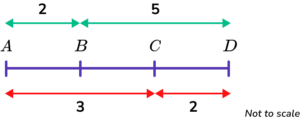
The total for the ratio parts needs to be the same, so we scale up using the lowest common multiple.
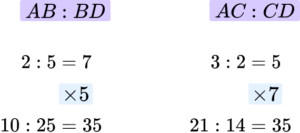
If we write the new ratios onto the line, we can then see what the different sections of the line are.
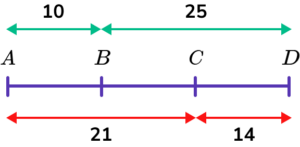
The sections BC will be 21-10=11 .
Or alternatively BC can be calculated by 25-14=11 .
The final answer is
Ratio to graph
Ratio problems may also involve coordinates.
Points A and B have the coordinates (1,1) and (11,6) respectively.
Point C lies on the line AB such that AC:CB=3:2
Find point C .
The ratio 3:2 has 5 parts. We need to split the line AB into 5 equal parts. AC will be \frac{3}{5} of the line and CB will be \frac{2}{5} of the line.
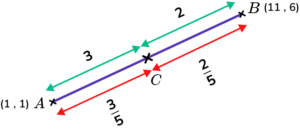
We can do this by looking at the x -coordinates and the y -coordinates separately.
The distance in the x direction is 11 - 1 = 10
So the x -coordinate will be 1 + \frac{3}{5} ✕ 10 = 7
The distance in the y direction is 6 - 1 = 5
So the x -coordinate will be 1 + \frac{3}{5} ✕ 5 = 4
So point C is at (7,4) .
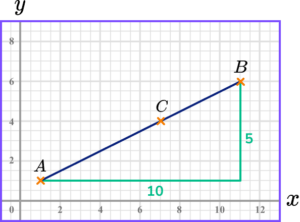
Ratio examples
Example 1: how to work out a ratio.
The ratio of people who prefer skiing holidays to beach holidays is expressed as a bar model. State the ratio of people who prefer skiing holidays to the total number of people.
- State the number of shares in the required part of the ratio.
The Beach has 3 parts.
2 State the number of shares in the other part(s) as required.
The total number of parts is 1+3=4
3 Write the ratio using a colon : (and simplify when necessary).
Example 2: simplifying ratios
Use a bar model to simplify the ratio 12:6
Calculate the highest common factor of the parts of the ratio.
Representing the ratio 12:6 as a bar model, we have
Where purple represents 12 shares, and yellow represents 6 shares.
HCF(12,6)=6
Divide each part of the ratio by the highest common factor.
As the highest common factor is 6 , we divide the bar above into six bars containing the same amount of purple shares, and yellow shares.
Each bar is the ratio 2:1 .
Solution : 2:1
Example 3: dividing ratios
Shirley wants to make shortbread for a party. The recipe requires flour, butter and sugar in the ratio 3:2:1 .
Shirley has 610g of flour, 450g of butter, and 750g of sugar.
Does she have enough of each ingredient to make 1.2kg of shortbread?
The weight of each ingredient in a shortbread is shown as a bar model below.
Add the parts of the ratio together.
Adding up the number of shares in the bar we have 3+2+1=6
Divide the quantity by the sum of the parts.
1.2kg is equal to 1200g (multiply by 1000 ).
1200 \div 6=200g per share.
Multiply the share value by each part in the ratio.
Looking at each ingredient, we have
Flour = 200 \times 3=600g
Butter = 200 \times 2=400g
Sugar = 200 \times 1=200g
Answer : Yes she has enough of each ingredient.
Example 4: ratio to fraction
The diagram below shows the days of the month that were above or below 20^{\circ}C on average.
Complete the bar model to show the fraction of days in the month at were above 20^{\circ}C
Add the parts of the ratio for the denominator.
By counting the number of days in the month, there are 31 days.
We therefore need to split the bar into 31 equal shares.
State the required part of the ratio as the numerator.
The first number in the ratio represents the number of days above 20^{\circ}C and so we need to colour in 11 of these shares in red, the rest are blue.
This means that 11 out of the 31 days were warmer than 20^{\circ}C and so the fraction is \frac{11}{31} .
Solution: \frac{11}{31}
Example 5: problem solving
The ratio of a:b=3:2 . The ratio of b:c=3:5 . What is the ratio of a:c ?
Identify key information within the question.
Drawing these ratios using bar models, we have:
Know what you are trying to calculate.
Instinctively, you may think that the ratio of a:c is 3:5 but this would be incorrect. We need to calculate the ratio of a:c when the number of shares of b are the same for each ratio.
We therefore need to calculate the lowest common multiple of the two values of b, find the equivalent ratios of a:b and b:c when b is the same value, then we can state the ratio a:c.
Use prior knowledge to structure a solution.
The first five multiples of 2 and 3 are:
Multiples of 2 = 2, 4, {\color{red} 6}, 8, 10
Multiples of 3 = 3, {\color{red} 6}, 9, 12, 15
LCM(2,3) = {\color{red} 6}.
We now find the equivalent ratios.
Multiplying both parts of the ratio of a:b by 3 , we get the ratio 9:6 .
Multiplying both parts of the ratio of b:c by 2 , we get the ratio 6:10
As the value of b is the same for both ratios, the ratio for a:c can be stated by counting the number of shares in each part.
This ratio is already in its lowest terms and so cannot be simplified further.
Example 6: ratio scales
A map has the scale of 1cm:2km . The distance between two points on the map is 3.5cm . Calculate the distance between the two points in real life.
Write down two related quantities from the question / diagram.
Using a bar model, we can show the ratio of the map to the actual distance as
Calculate the scale factor / ratio of the two quantities.
We know that the ratio between the two quantities is 1cm:2km . Remember that these are different units.
Use the scale factor to determine other scaled values.
Every 1cm on the map represents 2km in real life and so by multiplying the number of shares by 3.5 , we will calculate the actual distance
Here, 3.5cm on the map is equal to 7km in real life.
Common misconceptions
- Ratio written in the wrong order
A common error is to write the parts of the ratio in the wrong order. E.g. The number of dogs to cats is given as the ratio 12:13 but the solution is incorrectly written as 13:12 .
- Ratios and fractions confusion
E.g. The ratio 2:3 is incorrectly expressed as the fraction \frac{2}{3} and rather than the correct answer of \frac{2}{5} . This is a misunderstanding of the sum of the parts of the ratio. The sum of all of the parts of the ratio gives us the denominator of the fraction.
- Incorrect value for the numerator
A common error is to incorrectly state the numerator from the ratio.
E.g. The number of mugs to glasses in a kitchen is written as the ratio 8:11 respectively. Write the fraction of mugs in the kitchen. The solution could be incorrectly written as \frac{11}{19} taking the value for the numerator as the number of glasses, not the number of mugs. The correct answer is \frac{8}{19} .
- Not fully simplified
A common error is to not write a ratio in its simplest form by not finding the highest common factor. E.g. Simplify the ratio 12:18 Dividing both numbers by 2 will leave a ratio of 6:9 . This can be simplified further by dividing by 3 to get the ratio 2:3 , which is the correct answer.
- Not simplifying all parts of the ratio
When simplifying a ratio with more than two parts, not all of the parts are simplified. For example, “Simplify the ratio 12:6:15 ” is incorrectly written as 2:6:3 as the middle part is not cancelled down.
- Dividing the ratio by each part
A common error is to divide a value by each part of the ratio. E.g. Divide £120 into the ratio 2:3 The incorrect answer if produced by dividing £120 by 2 , and then dividing £120 by 3 to get £60:£40 . This does not make sense as the ratio is not equivalent to the original. The correct answers requires that the amount is divided by the sum of the parts in the ratio 120 \div (2+3)=120 \div 5=£24, then this value multiplied by each part in the ratio 24 \times 2=£48 , 24 \times 3=£72
- Mixing units
Make sure that all the units in the ratio are the same. For example, in example 6 , all the units in the ratio were in millilitres. We did not mix ml and l in the ratio.
- Simplifying the answer
When sharing a quantity into the ratio, you are finding an equivalent ratio so you do not need to simplify the answer.
Practice ratio questions
1. A musical requires 200 costumes. 140 costumes are allocated to the background dancers whilst the rest are for the starring roles. Write the ratio of the costumes for starring roles to backing dancers in the simplest form.

200-140=60 starring role costumes
The ratio is therefore 60:140.
The highest common factor of 60 and 140 is 20:
There are 3 shares for starring roles, and 7 shares for background dancers, hence the ratio 3:7.
2. 50 people were asked about their use of social media; everyone participated. 24 boys were asked. Write the ratio of boys to girls who participated in the study in its simplest form.
Use the bar model below to help you.
Colouring in 24 out of the 50 shares we have
This leaves us with 26 shares that are left white.
The highest common factor of 24 and 26 is 2 .
We can therefore halve the number of shares on each side of the ratio to get
Counting the shares, we now have the ratio of 12:13.
3. A soap “Duo” is made by combining lavender soap with lemon soap. Each bar of soap weighs 330g . If the ratio of lavender to lemon is 4:7 , how many grams of lemon soap are in each bar?
As there are 7+4=11 shares within the ratio
330 \div 11=30g per share
The amount of Lemon in the soap is equal to 7 \times 30=210g
4. The fraction of bananas in a bowl is \frac{13}{20} . Calculate the ratio of bananas to other pieces of fruit in the bowl.
The total number of pieces of fruit is 20 . The number of bananas is 13 . As a bar model, this looks like
The number of other pieces of fruit is therefore 7 (this is calculated by 20-13=7 or counting the number of purple bars above).
The ratio of bananas to other pieces of fruit is therefore 13:7.
5. Mel, Nicole and Orla use a bar model to show their ages.
Orla is 12 years older than Nicole. How old is Mel?
We currently have the ratio 5:6:10.
If Orla is 12 years older than Nicole, and this is 4 shares of the ratio, we have 4 shares equal to 12 years.
1 share is equal to 3 years.
As Mel has 5 shares, 5 \times 3=15 years old.
6. A model soldier is scaled down using a ratio of 5cm:1cm . Given that the height of the soldier in real life is 182cm , calculate the height of the model.
Using a bar model, we have the ratio 5:1 drawn as
If the soldier is 182cm in real life, the value of one share within the bar model is equal to 182 \div 5=36.4cm.
This means the height of the model is 36.4cm.
Ratio GCSE questions
1. An orchestra has 100 musicians. 60\% of them play a string instrument. The ratio of violin players to the other string instruments is 4:11 .
How many musicians play the violin in the orchestra?
16 violin players
2. A florist sells 3 sizes of rose bouquets: regular, large, and extra large. The regular bouquet contains 5 roses, the large bouquet contains 8 roses, and the extra large bouquet contains 12 roses.
In one February, she sells 16 regular bouquets, 16 large bouquets and 18 extra large bouquets.
(a) How many roses are required for these orders?
(b) The ratio of roses that were used to not used in the bouquets was 8:3. What fraction of the roses were not used in the bouquets?
(c) How many roses were bought in total?
3. During one weekend, 256 planes depart from an airport to go to France and Spain in the ratio of 3:5 . On a bank holiday weekend, the number of flights increases by 68, giving the new ratio of 4:5.
How many more flights went to France on the bank holiday weekend?

Learning checklist
You have now learned how to:
- Use ratio notation, including reduction to simplest form
- Divide a given quantity into 2 parts in a given part: part or part: whole ratio; express the division of a quantity into 2 parts as a ratio
- Understand that a multiplicative relationship between 2 quantities can be expressed as a ratio or a fraction
The next lessons are
- Compound measures
- Best buy maths
Still stuck?
Prepare your KS4 students for maths GCSEs success with Third Space Learning. Weekly online one to one GCSE maths revision lessons delivered by expert maths tutors.

Find out more about our GCSE maths tuition programme.
Privacy Overview

- 5,000+ Topicwise Questions & Answers Included
- Best for 11+ Grammar & Independent School Exams
- Improve Speed, Accuracy & Time Management
GCSE Ratio & Proportion Questions and Answers

These detailed solutions are visible only for premium members
Please register to unlock over 135+ GCSE Maths Solved Past & Predicted Papers. 5,000+ Topicwise Questions with Step by Step Solutions
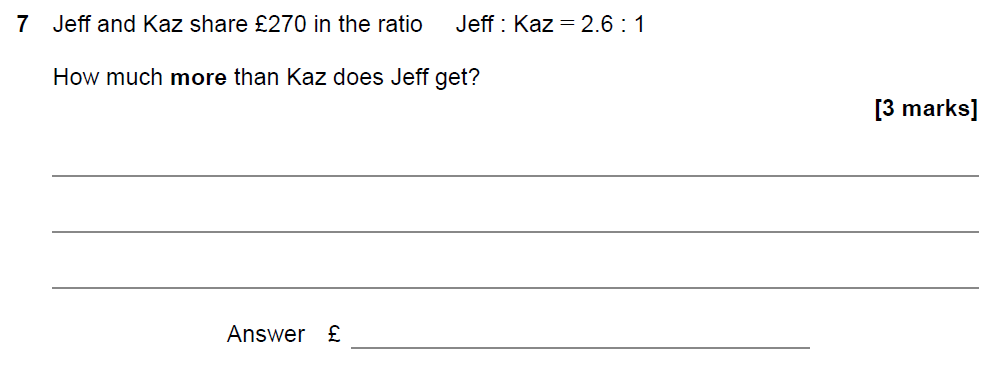
GCSE Topics
- Time Series Graphs (1)
- Interpreting and Comparing Data (1)
- Scatter Graph (1)
- Substitution (59)
- Graphs of inequalities (12)
- Equation of a Circle (22)
- Composite Functions (14)
- Factorising Quadratics (27)
- Speed Distance Time (74)
- Velocity-time Graphs (18)
- Iterative Methods (16)
- Time Tables (4)
- Expanding Brackets (61)
- Expanding Double Brackets (4)
- Rearranging Formulae (40)
- Algebraic Expressions (190)
- Factorizing Expressions (14)
- Parallel and Perpendicular Lines (36)
- Function Machine (20)
- Algebraic Formulae (20)
- Simplifying Expressions (128)
- Quadratic Graphs (51)
- Collecting like Terms (50)
- Linear Inequalities (48)
- Turning Points (22)
- Indices (112)
- Quadratic Inequalities (10)
- Sketching Graphs (67)
- Order of Operations (BIDMAS) (16)
- Laws of Indices (70)
- Fractional Indices (28)
- Sequences (74)
- Exponential Graphs (16)
- Cubic Equations (18)
- Algebraic Indices (16)
- Arithmetic Sequences (43)
- Gradients of Curves (13)
- Rates of Change (5)
- Negative Indices (16)
- Quadratic Sequences (19)
- Factorizing Quadratics (11)
- Formulae (3)
- Algebraic Fractions (23)
- Coordinates (101)
- Cubic and Reciprocal Graphs (19)
- Linear Equations (190)
- Gradient of a line (67)
- Transforming Graphs (8)
- Simultaneous Equations (42)
- Equations of Straight Lines (91)
- Areas under curves (17)
- Geometric Sequences (11)
- Quadratics and Fractions (1)
- Quadratic Equations (104)
- Straight Line Graphs (74)
- Algebraic Proof (39)
- Algebraic Equations (308)
- Writing Formulae (1)
- Quadratic Formula (22)
- Real-life Graphs (14)
- Function Notation (26)
- Completing the Square (11)
- Trigonometric Graphs (18)
- Inverse Functions (14)
- Factorising Expressions (30)
- Scale diagrams and maps (17)
- Ratio & Proportion (248)
- Compound Measures (26)
- Proportion and Graphs (12)
- Unit Conversions (84)
- Growth and Decay (9)
- Density (24)
- Direct and Inverse Proportion (62)
- Scale Drawings and Maps (26)
- Transformations (54)
- Reflection (30)
- Polygons (39)
- Pyramid (12)
- Area and Perimeter (179)
- Rotations (25)
- Scale Factor (39)
- 3D Shapes (74)
- Translations (25)
- Parallel Lines (22)
- Rotational Symmetry (9)
- Volume & Surface Area (87)
- Enlargement (27)
- Triangles (189)
- Similar Shapes (34)
- Squares (41)
- Congruent Triangles (27)
- Symmetry (18)
- Rectangles (68)
- Bearings (19)
- Line Symmetry (14)
- Nets of solids (2)
- Parallelograms (23)
- Trigonometry Lengths (73)
- Unit Conversion (2)
- Angles (135)
- Rhombus (7)
- Trigonometry Angles (98)
- 3D trigonometry (6)
- Pythagoras Theorem (45)
- Trapeziums (31)
- Sine Rule (21)
- Circles (1)
- 3D Pythagoras Theorem (8)
- Prisms (23)
- Cosine Rule (19)
- Constructing Perpendicular Lines (11)
- Circles, Sectors and Arcs (110)
- Vectors (55)
- Constructions (32)
- Cylinders (17)
- Plans and Elevations (15)
- Circle Theorems (33)
- Bar charts (29)
- Pictograms (14)
- Pie charts (26)
- Frequency Polygon (6)
- Box plots (18)
- Scatter graphs (28)
- Time series graphs (14)
- Averages and Range (33)
- Sampling (2)
- Line Graphs (14)
- Frequency Table (50)
- Cumulative Frequency (29)
- Mean, mode and Median (94)
- Comparing Data (16)
- Stem and Leaf Diagrams (4)
- Data and Sampling (13)
- Histograms (23)
- Frequency and Outcomes (12)
- Venn Diagrams (42)
- Set Notation (11)
- Conditional Probability (13)
- Independent Events (14)
- interpreting via collected data and calculated probabilitites (1)
- Comparing Probabilities (1)
- Probability (2)
- Sample space diagram (20)
- AND & OR Rules (56)
- Two way Tables (7)
- Relative Frequency (24)
- Tree diagrams (38)
- Geometric Mean (1)
- Arithmetic Mean (1)
- Comparing Statistical Measures (1)
- Fractions (173)
- Square Numbers (48)
- Upper and Lower Bounds (25)
- Mixed Numbers (27)
- Cube Numbers (30)
- Limits of Accuracy (20)
- Operations with fractions (41)
- HCF, LCM (34)
- Comparing Numbers (24)
- Factors, Multiples and Primes (88)
- Equivalent Fractions (16)
- Fractions of amounts (15)
- Simple and Compound Interest (36)
- Division (1)
- Fractions to decimals (29)
- Multipliers (21)
- Addition and Subtraction (57)
- Multiplication (1)
- Fractions to percentages (12)
- Fraction problems (22)
- Arithmetic Word Problems (182)
- Percentages (222)
- Ordering Numbers, (18)
- Decimals to Fractions (23)
- Rounding Numbers (87)
- Reverse Percentages (13)
- Odd and Even Numbers (28)
- Estimation (80)
- Decimals to Percentages (6)
- Multiplication and Division (96)
- Percentage Change (56)
- lcm word problems (11)
- Laws of Indices (16)
- Significant Figures (77)
- Order of Operations (13)
- HCF Word Problems (2)
- Profit and Loss (1)
- Decimals (137)
- Percentage Profit and Loss (21)
- Square Roots (41)
- Decimal Places (77)
- Ordering Fractions (5)
- Recurring Decimals (19)
- Repeated Percentage Change (11)
- Rounding Numbers, Estimation, Significant Figures, Decimal Places (14)
- Percentage to Fractions (8)
- Multiplying Decimals (19)
- Calculator Skills (50)
- Product Rule (11)
- Place Value (11)
- Dividing Decimals (27)
- Standard form (48)
- Error Intervals (26)
- Cube Roots (14)
- Pecentage Change (8)
- Ordering Decimals (8)
- Counting Strategies (24)
- Negative Numbers (14)
The main topics in GCSE Maths are:
- Ratio, Proportion and Rates of Change
- Geometry and Measures
- Statistics
- Probability
- Statistical Measures
- Data Visualisation
With regular practice of GCSE Maths topic-wise questions and GCSE Maths past pacers , you can easily score high marks.
Although many people think of GCSE maths as a difficult subject, with the correct training and preparation,you can master it in time. You can practice GCSE Maths topic-wise questions daily to improve speed, accuracy, and time and to score high marks in the GCSE Maths exam.
A grade of 4 or 5 would be considered "good" because the government has established a 4 as the passing grade; a grade of 5 is seen as a strong pass. Therefore, anything that exceeds this level would be considered good. You can practice GCSE Maths topic-wise questions to score good grades in the GCSE Maths exam.
You can get a high score in GCSE Maths through meticulous practice of GCSE Maths topic-wise questions and GCSE Maths past papers .
Subscribe to Newsletter
** Get 10% off coupon code on your first order, valid sitewide.
PiAcademy Partners

Follow us on

More than 20,000 registered members!
Exam papers.
© 2014 - 2024 PiAcademy Limited, All Rights Reserved

The resources on this page will hopefully help you teach AO2 and AO3 of the new GCSE specification - problem solving and reasoning.
This brief lesson is designed to lead students into thinking about how to solve mathematical problems. It features ideas of strategies to use, clear steps to follow and plenty of opportunities for discussion.

The PixiMaths problem solving booklets are aimed at "crossover" marks (questions that will be on both higher and foundation) so will be accessed by most students. The booklets are collated Edexcel exam questions; you may well recognise them from elsewhere. Each booklet has 70 marks worth of questions and will probably last two lessons, including time to go through answers with your students. There is one for each area of the new GCSE specification and they are designed to complement the PixiMaths year 11 SOL.
These problem solving starter packs are great to support students with problem solving skills. I've used them this year for two out of four lessons each week, then used Numeracy Ninjas as starters for the other two lessons. When I first introduced the booklets, I encouraged my students to use scaffolds like those mentioned here , then gradually weaned them off the scaffolds. I give students some time to work independently, then time to discuss with their peers, then we go through it as a class. The levels correspond very roughly to the new GCSE grades.
Some of my favourite websites have plenty of other excellent resources to support you and your students in these assessment objectives.
@TessMaths has written some great stuff for BBC Bitesize.
There are some intersting though-provoking problems at Open Middle.
I'm sure you've seen it before, but if not, check it out now! Nrich is where it's at if your want to provide enrichment and problem solving in your lessons.
MathsBot by @StudyMaths has everything, and if you scroll to the bottom of the homepage you'll find puzzles and problem solving too.
I may be a little biased because I love Edexcel, but these question packs are really useful.
The UKMT has a mentoring scheme that provides fantastic problem solving resources , all complete with answers.
I have only recently been shown Maths Problem Solving and it is awesome - there are links to problem solving resources for all areas of maths, as well as plenty of general problem solving too. Definitely worth exploring!
Resourceaholic
Ideas and resources for teaching secondary school mathematics
- Blog Archive
20 December 2017
New gcse: ratio.
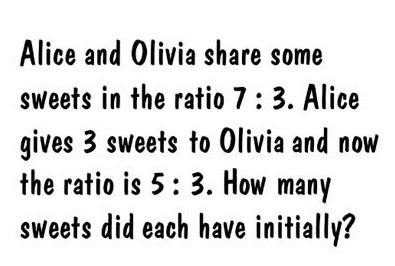
- Mel from JustMaths collated ratio Higher GCSE questions from sample and specimen papers here , and has written up her solutions here .
- If you subscribe to MathsPad then you'll be pleased to hear that they have lovely resources for ratio including a set of questions for Higher GCSE with loads of examples like the problems I've featured in this post.
- Don Steward has plenty of ratio tasks including his set of ' Harder Ratio Questions ' and a really helpful collection of GCSE ratio and proportion questions .
- On MathsBot you can generate ratio questions, revision grids and practice papers. Select 'ratio, proportion and rates of change' at the top.
- There are exam style questions in this collection from Lucy Kilgariff on TES.
- OCR has a 'Calculations with Ratio' Topic Check In and AQA has a Ratio and Proportion Topic Test .
- David Morse of Maths4Everyone has shared a set of revision exercises and ratio exam style questions .

20 comments:

My ratio pages don't get much attention - not sure why since I think they're instructive and easy to use. They don't support the particular type of harder questions described in the post (but I'll look to add something along those lines), but they do help understanding the concept of a ratio and it's utility. Manipulation of ratio quantities: http://thewessens.net/ClassroomApps/Main/ratios.html?topic=number&path=Main&id=7 Introduction to the ratio concept: http://www.thewessens.net/blog/2015/03/19/ratios-the-super-fractions/ Bar model visualisation of ratios: http://thewessens.net/ClassroomApps/Models/BarModels/visualfractionratio.html?topic=models&path=Models&id=17 Multiplicative word problems: http://thewessens.net/ClassroomApps/Models/BarModels/multiplicationwordproblems.html?topic=models&path=Models&id=8 Ken

Fantastic! Thanks Ken.

Thanks so much for your blog on ratio question types. Although I've been a maths teacher/tutor for over 30 year, ratio has always been a bug bear for me. I could wing it with old style gcse because I learnt the types of solutions required, however I have been stressed on the new types. This blog has made me think through ratios and I am certainly a lot happier. Bryan
Excellent, I'm so pleased it helps.
On your fractions approach, a quick trick is to realise that a/c = a/b x b/c. Makes it quite quick to work out (That is, if the students are good with cancelling down when multiplying). However, what I find confuses students about writing ratios as fractions is that it confuses the part:part idea of a ratio with the part:whole idea of a fraction. Perhaps that's why it's somewhat counter-intuitive. Also, final point is that ratios (fractions) and vectors is another application of harder ratio questions that often pops up on the new GCSE. Thanks for the post, Farah
Thanks for the comment!
This is a fabulous resource on work that is missing from the new GCSE texts that I have seen. Lovely challeging questions to make students think.
Thanks! Glad it's helpful.
I've been using equivalent ratios for these type of questions. Find what doesn't change - the total number of sweets. Write ratios as equivalent ratios where the parts that doesn't change are the same. 3:7 has 10 parts, 3:5 has 8 parts LCM of 8 and 10 is 40 Ratios are 12:28 and 15:25 Number of sweets given is 3. Also works for following question Ratio of blue to red counters in a bag is 1:2, I add 12 blue counters and the ratio is 5:7. How many red counters are in the bag? What doesn't change? Red counters LCM of 2 and 7 is 14 Ratios are 7:14 and 10:14 3 parts are 12 counters, 1 part is 4 counters and 14 parts are 56 red counters. Also Jill is 4 times older than Jack. In 14 years time the ratio of Jack's age to Jill is 5:7. How old is Jill now? Ratios are 1:4 and 5:7. What doesn't change? The difference between their ages Find two equivalent ratios where difference between them is the same. 4 - 1 = 3 and 7 - 5 = 2 LCM of 2 and 3 is 6 Equivalent ratios are 2:8 and 15:21 13 parts = 26 years, 1 part is 2 years, Jill is 16.
This is the approach I use. I think it's logical.
Thank you! Yes, this is logical. Same approach as bar modelling (but without the visual).
Oops, my mistake, third example should be .....in 26 years time the ratio of their ages is 5:7 ..... I did try to represent these using bar modelling at first but struggled to find a model that was intuitive and actually helped with the question. I would be grateful if anyone has ideas on this.
Although some bar modelling experts would disagree, I don't think bar modelling is intuitive/helpful for harder ratio questions. Bar modelling is fantastic for easier ratio questions, but when the questions get more complicated it's often really hard to figure out how to draw the scenario - definitely not as easy as some people make out!
Thank you for the post. Brilliant as usual. I actually did the sweets question in my class once. I simply said that Alice fraction of sweets changed from 7/10 to 5/8 when she gave the 3 sweets away. If we just subtract those fractions, the fraction remaining, 7/10 - 5/8 = 3/40. This means that Alice originally had 40 sweets.
Hadnt considered tis method but I love it
Thanks Stephen. I guess it makes sense, as the fraction lost is equivalent to the 3 sweets divided by the total.
Love this! Thanks for sharing.
Hi Jo, thanks for the post which I came across via a tweet you put out a couple of days ago - which also tied in with a question and the same method I saw in my step-daughters book the very next day - freaky! It is a more compact method than I would normally use in my teaching and will be switching to it. I think the only tweak I might make is to write the algebra ratio above the numeric one so the starting fractions are (7x-3)/5 : (3x+3)/3 The reason being that some students might get a little scared seeing algebra as part of the denominator but less so when faced with a number.
Good idea - thank you!
Hi Jo, One method I use when teaching questions like the first one above (Alice gives 3 sweets to Olivia) is the following. To begin with Alice has 7/10 of the sweets and then after giving three to Olivia, her share has reduced to 5/8 of the sweets. So Alice's share has reduced by (7/10 - 5/8=) 3/40 which is equivalent to 3 sweets, therefore there must be 40 sweets in total. Students can then proceed in answering the relevant question. I must admit I only use this method with the top sets.

Simplifying Ratios Pixel Picture ( Editable Word | PDF | Answers )
Simplifying Ratios Odd One Out ( Editable Word | PDF | Answers )
Equivalent Ratios Match-Up ( Editable Word | PDF | Answers )
Working with Ratio Practice Strips ( Editable Word | PDF | Answers )
Dividing in a Ratio Practice Strips ( Editable Word | PDF | Answers )
Dividing in a Ratio Fill in the Blanks ( Editable Word | PDF | Answers )
Dividing in a Ratio Crack the Code ( Editable Word | PDF | Answers )
Combining Ratios Practice Strips ( Editable Word | PDF | Answers )
Sharing and Combining Ratios Practice Strips ( Editable Word | PDF | Answers )
Solving Ratio Problems Practice Strips ( Editable Word | PDF | Answers )
Solving Ratio Problems Practice Grid ( Editable Word | PDF | Answers )
Harder Ratio Problems Practice Strips ( Editable Word | PDF | Answers )
Fractions and Ratio Worded Problems Practice Strips ( Editable Word | PDF | Answers )
Unitary Method Practice Strips ( Editable Word | PDF | Answers )
Unitary Method Match-Up ( Editable Word | PDF | Answers )
Best Buys Practice Strips ( Editable Word | PDF | Answers )
Currency Conversions Practice Strips ( Editable Word | PDF | Answers )
Proportion Worded Problems Practice Strips ( Editable Word | PDF | Answers )
Proportion Worded Problems Practice Grid ( Editable Word | PDF | Answers )
Mixed Ratio and Proportion Revision Practice Grid ( Editable Word | PDF | Answers )
Ratio Problem Solving ( Edexcel GCSE Maths: Foundation )
Revision note.

Ratio Problem Solving
What type of ratio problems could i be asked to solve.
- Writing ratios
- The link between ratios and fractions
- Equivalent ratios
- Simplifying ratios
- Sharing an amount in a given ratio
- E.g., Kerry is given $30 more than Kacey who is given $50
- E.g., Kerry and Kacey are sharing money in the ratio 8 : 5, Kacey gets $50
- E.g., Kerry and Kacey are sharing money in the ratio 8 : 5 whilst Kacey is also sharing money with Kylie in the ratio 1 : 2
How do I solve a ratio problem when given the difference between two parts?
- Find the difference in the number of parts between the two quantities in the ratio
- Compare the difference in the number of parts with the difference between the actual numbers
- Simplify to find out the value of one part
- Multiply the value of one part by the number of parts for each quantity in the ratio
- Multiply the value of one part by the total number of parts to find the total amount
Given one quantity of a ratio, how can I find the other quantity?
- Compare the given quantity with the relevant number of parts in the ratio
- Simplify to find the value of one part
- Multiply the value of one part by the number of parts in the remaining quantity in the ratio
How do I combine two ratios to make a three-part ratio?
- Identify the link between the two different ratios
- Find equivalent ratios for both original ratios, where the value of the link is the same
- Join the two, two-part ratios into a three-part ratio
Worked example
The ratio of cabbage leaves eaten by two rabbits, Alfred and Bob, is 8 : 4 respectively. It is known that Alfred eats 12 more cabbage leaves than Bob for a particular period of time. Find the total number of cabbage leaves eaten by the rabbits and the number that each rabbit eats individually.
The difference in the number of parts is
8 - 4 = 4 parts
This means that
4 parts = 12 cabbage leaves
Dividing both by 4
1 part = 3 cabbage leaves
Find the total number of parts
8 + 4 = 12 parts
Find the total number of cabbage leaves
12 × 3 = 36
36 cabbage leaves in total
Find the number eaten by Alfred
24 cabbage leaves
Find the number eaten by Bob
12 cabbage leaves
A particular shade of pink paint is made using 3 parts red paint, to two parts white paint.
Mark already has 36 litres of red paint, but no white paint. Calculate the volume of white paint that Mark needs to purchase in order to use all of his red paint, and calculate the total amount of pink paint this will produce.
The ratio of red to white is
Mark already has 36 litres of red, so
36 litres = 3 parts
Divide both sides by 3.
12 litres = 1 part
The ratio was 3 : 2 Find the volume of white paint, 2 parts
2 × 12 = 24
24 litres of white paint
In total there are 5 parts, so the total volume of paint will be
5 × 12 = 60
60 litres in total
In Jamie’s sock drawer the ratio of black socks to striped socks is 5 : 2 respectively. The ratio of striped socks to white socks in the drawer is 6 : 7 respectively.
Calculate the percentage of socks in the drawer that are black.
Write down the ratios
B : S = 5 : 2 S : W = 6 : 7
S features in both ratios, so we can use it as a link Multiply the B : S ratio by 3 to find an equivalent ratio Both ratios are now comparing to 6 striped socks
B : S = 15 : 6 S : W = 6 : 7
Link them together
B : S : W = 15 : 6 : 7
15 + 6 + 7 = 28
This means 15 out of 28 socks are black Find 15 out of 28 as a decimal by completing the division
Convert to a percentage Multiply by 100 and round to 3 significant figures
53.6 % of the socks are black
You've read 0 of your 10 free revision notes
Get unlimited access.
to absolutely everything:
- Downloadable PDFs
- Unlimited Revision Notes
- Topic Questions
- Past Papers
- Model Answers
- Videos (Maths and Science)
Join the 100,000 + Students that ❤️ Save My Exams
the (exam) results speak for themselves:
Did this page help you?
Author: Naomi C
Naomi graduated from Durham University in 2007 with a Masters degree in Civil Engineering. She has taught Mathematics in the UK, Malaysia and Switzerland covering GCSE, IGCSE, A-Level and IB. She particularly enjoys applying Mathematics to real life and endeavours to bring creativity to the content she creates.
- International
- Education Jobs
- Schools directory
- Resources Education Jobs Schools directory News Search
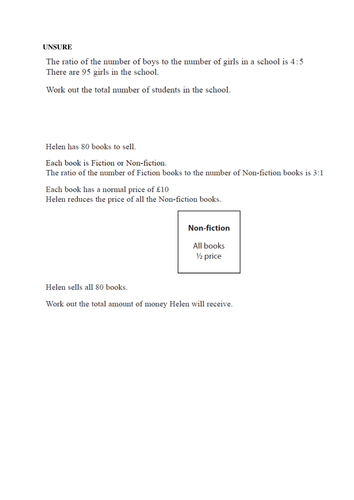
Ratio New GCSE Questions
Subject: Mathematics
Age range: 14-16
Resource type: Worksheet/Activity
Last updated
9 April 2020
- Share through email
- Share through twitter
- Share through linkedin
- Share through facebook
- Share through pinterest

Creative Commons "Sharealike"
Your rating is required to reflect your happiness.
It's good to leave some feedback.
Something went wrong, please try again later.
Very useful - thank you!
LawrenceHouldsworth
Most welcome, glad it was helpful!
Empty reply does not make any sense for the end user
Excellent resource
Thank you, I am glad you liked it!
chrislankester
Another reallygood resource - thanks!
Most welcome!
Good resource for a topic with not much material available. Nicely differentiated.
Thanks for the review, I am glad you liked it!
Good range of type of questions, and clear differentiation. thank you.
Report this resource to let us know if it violates our terms and conditions. Our customer service team will review your report and will be in touch.
Not quite what you were looking for? Search by keyword to find the right resource:

COMMENTS
Subject: Mathematics. Age range: 14-16. Resource type: Worksheet/Activity. File previews. docx, 18.26 KB. Ratio problems that involve a bit of thinking, such as combining ratios. Perfect for practice for the new GCSE. Creative Commons "Sharealike". to let us know if it violates our terms and conditions.
Ratio problem solving GCSE questions. 1. One mole of water weighs 18 18 grams and contains 6.02 \times 10^ {23} 6.02 × 1023 water molecules. Write this in the form 1gram:n 1gram: n where n n represents the number of water molecules in standard form. (3 marks) Show answer. 2.
Skills practice for GCSE exam questions. Answers & free downloadable worksheet included. Maths Tutoring for Schools. ... Ratio tables are another technique for solving ratio problems. How to solve a proportion problem. As we have seen, ratio and proportion are strongly linked. ... The new ratio is 3a:4a-40 and this is equal to the ratio 6:7.
The new 9-1 GCSE Maths questions for ratio problems have changed to become more challenging for students over the years. This lesson shows you how to answer ...
Previous: Percentages of an Amount (Non Calculator) Practice Questions Next: Rotations Practice Questions GCSE Revision Cards
GCSE (1 - 9) Ratio Problems 2 Name: _____ Instructions • Use black ink or ball-point pen. • Answer all questions. • Answer the questions in the spaces provided - there may be more space than you need. • Diagrams are NOT accurately drawn, unless otherwise indicated. • You must show all your working out. Information
These are the Corbettmaths Textbook Exercise answers to Ratio: Problem Solving. Welcome; Videos and Worksheets; Primary; 5-a-day. 5-a-day GCSE 9-1; 5-a-day Primary; 5-a-day Further Maths; More. Further Maths; GCSE Revision; Revision Cards; ... GCSE Revision Cards. 5-a-day Workbooks. Primary Study Cards. Search. Search. Contact Us.
The ratio of the number of marbles of each colour is. The farmer wants the ratio of horses : cows to equal 5 : 3. Nadira has some T-shirts that are either white or blue or green. The numbers of T-shirts are in the ratio white : blue : green = 5 : 4 : 1. Questions and model answers on Ratio Problem Solving for the Edexcel GCSE Maths: Foundation ...
You may be given a ratio and asked to use the ratio to solve problems. For example, a purple paint in made by mixing red and blue paint in the ratio 2:3. Use the ratio to work out how many litres of red and blue paint are needed to make 40 litres of purple paint. Red:Blue=2:3 which has 5 parts in total. The total is the amount of purple paint.
5-a-day GCSE 9-1; 5-a-day Primary; 5-a-day Further Maths; More. Further Maths; GCSE Revision; Revision Cards; Books; Ratio: Problem Solving Textbook Exercise. Click here for Questions. Textbook Exercise. Previous: Ratio: Difference Between Textbook Exercise. Next: Reflections Textbook Exercise.
Skill 4: Part to Whole Ratios Sometimes you may see ratios x:y where y includes x.These are part : whole ratios. Example: Adam has some apples and oranges in his bag. The ratio of oranges to fruit in his bag is \textcolor{orange}{2}:\textcolor{blue}{7}.. a) Finding the fraction of a whole - What fraction of Adam's fruit are oranges? For every \textcolor{blue}{7} pieces of fruit, \textcolor ...
Hard. Very Hard. All Answers. 1 2 marks. In a box of pens, there are. three times as many red pens as green pens. and two times as many green pens as blue pens. For the pens in the box, write down. the ratio of the number of red pens to the number of green pens to the number of blue pens.
Ratio problem solving for the new GCSE answers 1) I have 3 types of shapes: triangle, square or circle in the ratio 3:6:1. The triangles are either red or blue. The ratio of red triangles to blue triangles is 4:5. Given that I have 12 red triangles, how many circles are there? 9 circles 2) In my house, the ratio of dogs to fish is 1:10.
A grade of 4 or 5 would be considered "good" because the government has established a 4 as the passing grade; a grade of 5 is seen as a strong pass. Therefore, anything that exceeds this level would be considered good. You can practice GCSE Maths topic-wise questions to score good grades in the GCSE Maths exam.
The resources on this page will hopefully help you teach AO2 and AO3 of the new GCSE specification - problem solving and reasoning. This brief lesson is designed to lead students into thinking about how to solve mathematical problems. It features ideas of strategies to use, clear steps to follow and plenty of opportunities for discussion.
Two worksheets on three way ratios that I found. The second one is really challenging. Answers included. A worksheet on equivalent ratios with algebra (created by myself). Answers included. These sub topics are new to the GCSE 9-1. Sometimes you've just got to create these things yourself!!!! Hope you find them useful.
We can write a:b:c as one ratio if we get the b parts to match. a: b can be written as 6:15. b:c can be written as 15:50. So a:b:c is 6:15:50. This shows that the ratio a:c is 6:50, which simplifies to 3:25. And here's another type of question: Punch is made my mixing orange juice and cranberry juice in the ratio 7:2.
In harder ratio questions, the information you are given may also involve fractions and/or percentages. In most of these questions the key is to remember that ratios can also be turned into fractions (or vice versa) For example, the ratio of staff to students in a school may be 3:37. That means the ratio divides the school into 3+37=40 parts.
Proportion Worded Problems Practice Strips ( Editable Word | PDF | Answers) Proportion Worded Problems Practice Grid ( Editable Word | PDF | Answers) Mixed Ratio and Proportion Revision Practice Grid ( Editable Word | PDF | Answers. . )
Ratio Revision - Worksheet with answers. Subject: Mathematics. Age range: 14-16. Resource type: Worksheet/Activity. File previews. pdf, 206.88 KB. This pdf is a worksheet of over 40 questions covering all that it needed for GCSE ratio. It is extensive and made for a good homework / revision sheet. This set of questions is aimed strictly at ...
The ratio was 3 : 2. Find the volume of white paint, 2 parts. 2 × 12 = 24. 24 litres of white paint. In total there are 5 parts, so the total volume of paint will be. 5 × 12 = 60. 60 litres in total. (c) In Jamie's sock drawer the ratio of black socks to striped socks is 5 : 2 respectively.
Subject: Mathematics. Age range: 14-16. Resource type: Worksheet/Activity. My resources are all free! And all maths...at the moment! File previews. docx, 149.05 KB. docx, 207.07 KB. A couple of worksheets I put together to try to train students in the style of questions on ratio common in the new GCSE.